RESTITVT ORIENTIS. Which Roman emperor restored the Orient (the Roman East)?
Why did it need restoring?
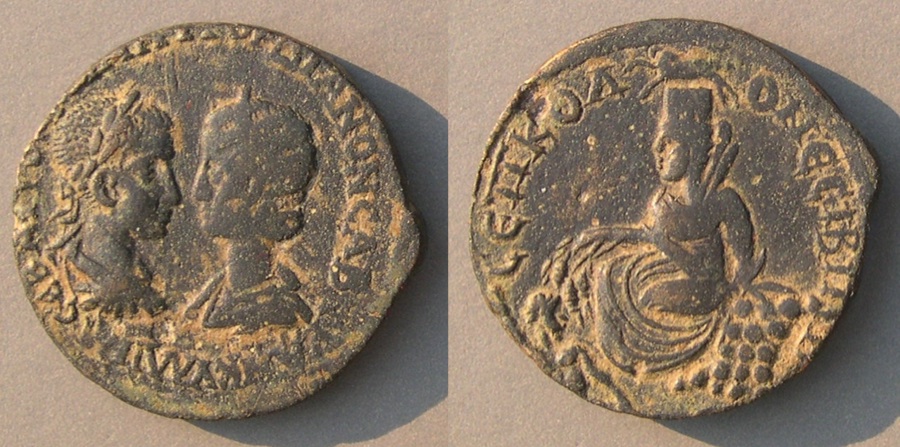 In the third and fourth centuries the Romans fought the Sasanians (Persians) for control of the East (Orient, in Roman terms). Sometimes Roman provincial cities including Nisibis and Singara in upper Mesopotamia were temporarily conquered by the Persians. Then a major Roman campaign would be mounted to attempt to return the region to Roman control. One such successful campaign was under Gordian III (238-244). (For more see a page about the coins of the Roman wars with Persia).
In the third and fourth centuries the Romans fought the Sasanians (Persians) for control of the East (Orient, in Roman terms). Sometimes Roman provincial cities including Nisibis and Singara in upper Mesopotamia were temporarily conquered by the Persians. Then a major Roman campaign would be mounted to attempt to return the region to Roman control. One such successful campaign was under Gordian III (238-244). (For more see a page about the coins of the Roman wars with Persia).
To the right. A large (32 mm) sestertius-sized coin of Gordian III and his wife, Tranquillina, from Nisibis ("NЄCIBI" from 1:30 to 4:00 on the reverse), with the city goddess Tyche seated on rocks with a river god swimming left below (at 7:00) and a tiny ram jumping left, head back, above her turreted headdress.
Gordian III recaptured Carrhae, Hatra, Nisibis, and the rest of Roman Mesopotamia. Gordian III was only 19 and clearly not the mastermind. Really the successes belonged to his Praetorian Prefect and father-in-law, Timesitheus, who died from illness, possibly aided by Philip, who replaced him. Then Gordian III died while still in Mesopotamia because of the treachery of Philip. Philip inherited the throne. In order to withdraw the troops safely, Philip (244-249) had to make peace with the Persians (Sasanians) at the cost of 500,000 denarii. Nevertheless, he issued coins claiming success.
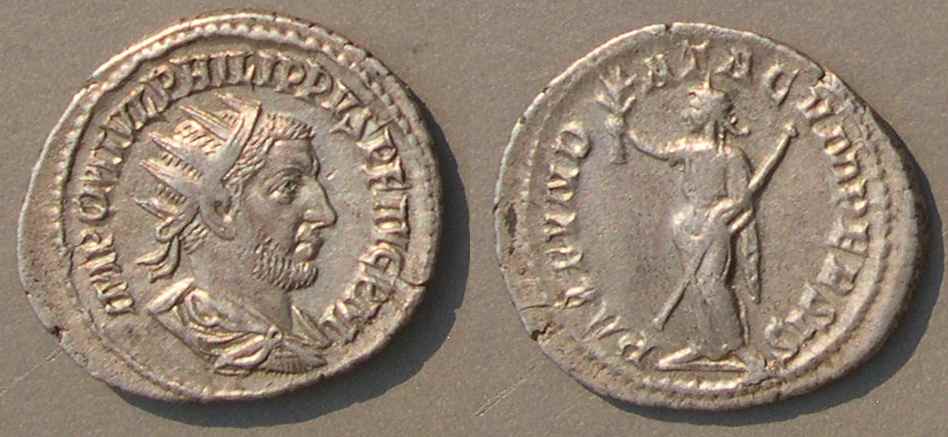
To the right. A 24 mm silver "antoninianus" of Philip with reverse PAX FVNDATA CVM PERSIS "Peace founded with Persia". Pax standing holding up olive branch.
Roman control did not last long. Upper Mesopotamia was recaptured by the Sasanians, c. 250-252, which explains the lack of later Roman provincial coins from the cities of Mesopotamia.
So, which emperor reconquered the Orient?
Valerian (253-260) took on the task of reconquering the Roman East. Our sources are unclear about whether he had just the one disastrous campaign which lead to his capture, or two campaigns, the first one successful which was undone upon withdrawal and therefore required a second. Regardless, Valerian issued coins claiming RESTITVT ORIENTIS. If there were two campaigns, the coins may be honestly reporting on the success of the first campaign. Or, if there was only one campaign, they may be premature propaganda reporting an anticipated success which didn't happen.
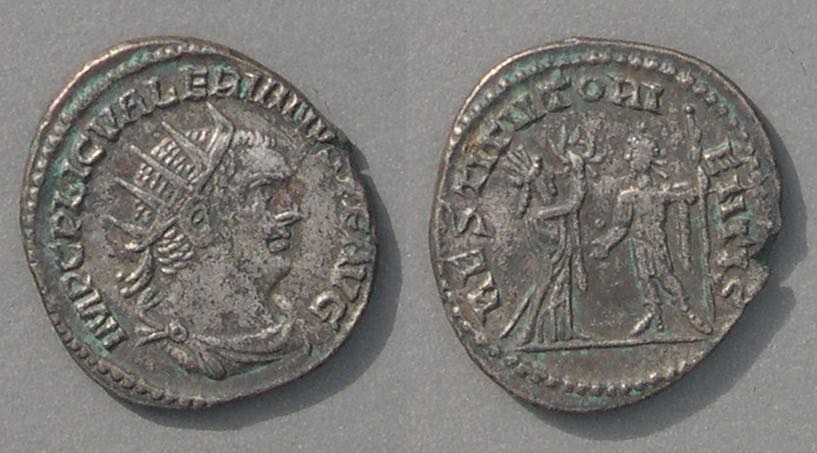
Valerian, 253-260.
21-19 mm. 3.78 grams.
RESTITVT ORIENTIS
The Orient, turreted, standing right and presenting a wreath to Valerian, standing left and holding scepter.
RIC 287c. Sear III 9967.
This same design was issued for his son and co-ruler, Gallienus (next).

Gallienus, 253-268.
22 mm. 3.79 grams.
The same design.
RIC 448. Sear III 10341.
The East was recaptured from the Sasanians by Odaenathus of Palmyra late in the time of Gallienus. Aurelian recovered it for the central empire by defeating Palmyra. So, for Aurelian coins with RESTITVT ORIENTIS are justified. He issued two designs.
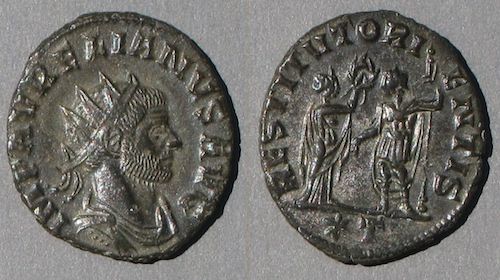 Aurelian, 270-275
Aurelian, 270-275
21-19 mm. 3.53 grams.
RESTITVT ORIENTIS
The same design as above under Valerian.
RIC 234. Sear III 11595.
 Aurelian, 270-275
Aurelian, 270-275
22-21 mm. 3.63 grams,
RESTITVT ORIENTIS
Emperor on right raising caped kneeling figure on left.
The kneeling figure seems to be turreted, which is a common feature of representations of Tyche on Roman provincial coins from the east.
C * P in exergue.
RIC 351. Sear III 11596.
One might think of the kneeling figure as begging--asking for aid. I prefer to think of it as thanking, with ceremony, the emperor, for the restoration of Roman rule.
Perhaps other, similar, types can help us decide what the reverse means. Next is an example of an AE2 of Gratian which has a relevant design, but it is not associated with an eastern war.
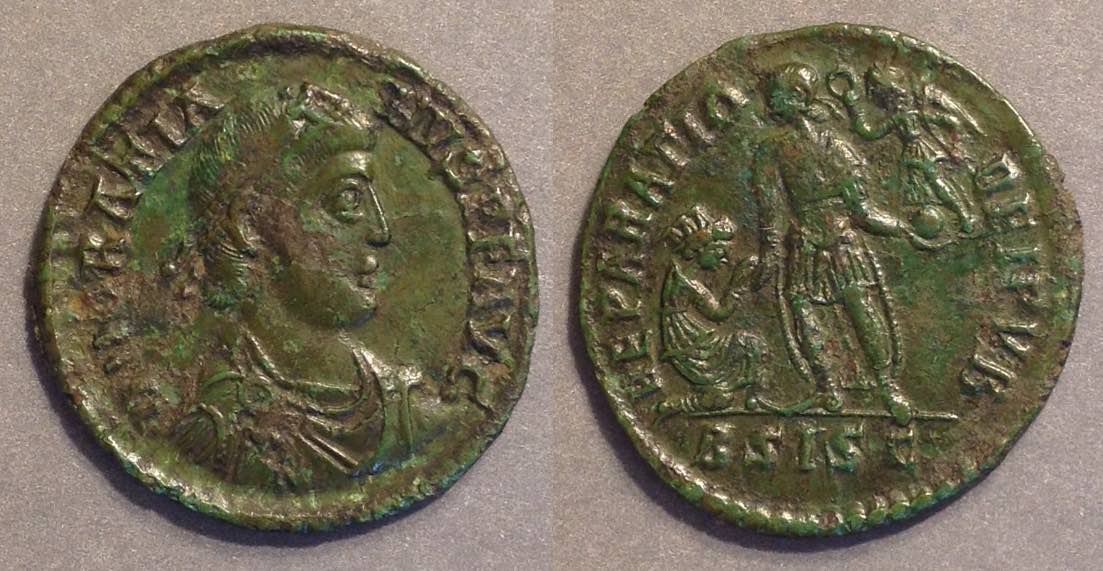 Gratian (367-389)
Gratian (367-389)
AE2. 23 mm. 4.23 grams.
RIC Siscia 26b2
Emperor and kneeling figure in a pose similar to that above. This time the emperor is crowned by Victory on a globe he is holding out in his left hand.
REPARATIO REIPVB. He is repairing/restoring the republic. (Ha!) Perhaps the lady is kissing his hand in gratitude. Maybe he is about to raise her up. Note the turreted crown on the woman. On this coin it seems that Victory (Crowning the emperor) makes the event happen (which event if any, is uncertain). Surely victory in the east made the event on Aurelian's coin happen, too. This is not an entreaty by the kneeling figure. It is a "Thank you!"
Conclusion. Aurelian restored the East and celebrated it with RESTITVT ORIENTIS types.
Go to a page on coins of Nisibis.
Go to the main Table of Contents of this educational site.
 In the third and fourth centuries the Romans fought the Sasanians (Persians) for control of the East (Orient, in Roman terms). Sometimes Roman provincial cities including Nisibis and Singara in upper Mesopotamia were temporarily conquered by the Persians. Then a major Roman campaign would be mounted to attempt to return the region to Roman control. One such successful campaign was under Gordian III (238-244). (For more see a page about the coins of the Roman wars with Persia).
In the third and fourth centuries the Romans fought the Sasanians (Persians) for control of the East (Orient, in Roman terms). Sometimes Roman provincial cities including Nisibis and Singara in upper Mesopotamia were temporarily conquered by the Persians. Then a major Roman campaign would be mounted to attempt to return the region to Roman control. One such successful campaign was under Gordian III (238-244). (For more see a page about the coins of the Roman wars with Persia). 


 Aurelian, 270-275
Aurelian, 270-275 Aurelian, 270-275
Aurelian, 270-275 Gratian (367-389)
Gratian (367-389)